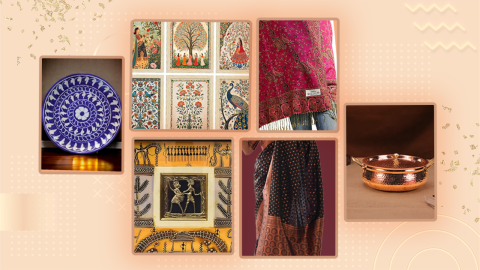The word "Handloom" refers to the process of weaving a piece of fabric on the loom, mainly with the help of a hand or sometimes some foot power as well or both. Since the Indus valley civilization, artisans in India have been crafting and weaving on the looms and even hundreds of years ago, Indian handlooms were in demand in many countries like Egypt, Rome, & China.
Handloom heritage
When India was fighting for her Independence, Gandhiji introduced the swadeshi movement to not just uplift the hand-woven fabric in India, but to also send the British Raj a strong statement of self-reliance. The swadeshi movement paved the way for the evolution of handloom in India. Today, even though the power looms are used widely, handlooms are making a slow but steady comeback and riding the trade with pride. The Government of India is encouraging the handloom artisans by introducing many policies that support the revival of handlooms.
Let’s understand the process of making handlooms in brief
It's laborious, its dexterous and its made in India! From fashion ramps to malls and just regular stores, hand crafted fabrics are back in vogue and donned by those in rural and urban India. The fabric has become a unifier of sorts. But do you know how the world of handloom operates? Whether its a simple saree or a designer kurti, its a process that require skill, patience and creativity. We list out the steps for you.
- Selecting the raw material
The artisans choose raw materials such as silk or wool or cotton or linen for the weaving purpose—different kinds of weave require different types of raw material. For example, Chanderi fabric is woven out of mulberry silk, and Kashmiri shawls are woven from wool. - Spinning the raw materials into yarns
At this stage, textile fibers and filaments are converted into yarn by spinning.
a. Spinning by hands: Spinning is a complex procedure. The quality of the yarn depends on the skills of the weaver and the staple length of the fiber. Handspun yarn is mainly used in cotton handloom manufacturing for converting cotton fibers and filaments into longer threads.
b. Spinning in the mills: Mill spun or mechanically spun yarns are the most used yarns these days. Huge spinning mills produce vast quantities of yarns by converting the filaments into longer threads. - Dyeing of the fabric
Dyeing or colouring of the yarn is the next step in the process of handloom manufacturing. There are three types of dyeing of the yarn.
a. Natural dye: The yarn gets its dye from natural ingredients such as flower petals, leaves, minerals, etc. Even vegetable dyes are a sub-type of natural dye.
b. Indigo dye: Indigo dyeing is one of the oldest forms of dyeing in the country, which uses the extracts of the Indigofera genus plants. It is popular in many industries because of its 100% natural ingredients.
c. Chemical dye: The chemical dye or a synthetic dye is, as the name suggests, a dye that uses a non-natural ingredient to colour the yarn. Handloom manufacturers have started using chemical dyes like Sulphur dye or a naphthol dye to survive the competition. - The bobbin winding & warping of the yarn
The charkha- the symbol of Indian handlooms and Gandhiji’s swadeshi movement, is the tool that enables this process. With the help of a charkha, the yarn is winded on the bobbins. The bobbins then allow the thread to be warped for the weaving on the loom. - The sizing
The sizing or street sizing is the process of applying natural adhesives on the stretched warps to strengthen and lubricate the yarn. Rice starch or potato starch, or wheat flour is used in sizing the warp. The warps are usually spread across streets; hence it’s called street sizing. - Arranging the warps on the looms
Each warp yarn is tied to the front and back beam through heddles and reed. The heddles separate the yarn into two parts, and reeds are comb-like structures that space the yarn into a proper format. The warping forms the vertical set of yarns, and the weft winding forms the horizontal set of the yarn. - Weft winding of the yarn
The weft yarn is attached to a shuttle (the device that’s usually seen hanging near the head of the weaver). The weft thread is thrown back and forth between the warp thread to make a weave. - Actual weaving on the loom
The weaving on the loom is a rhythmic composition of a warp and a weft. According to the weave plan, the feet hit the pedals to warp, and the hands move the weft to allow the heddle to pass through the warp.
Weaving a fabric on the handloom takes days to complete. It is a rigorous task. But it’s all worth the final craft that comes out of the handloom.
Do visit the Amazon Karigar initiative to know more about handloom artisans in India. This Gandhi Jayanti, let’s pledge to promote the art of our land, the art of the loom- “Handloom”.












